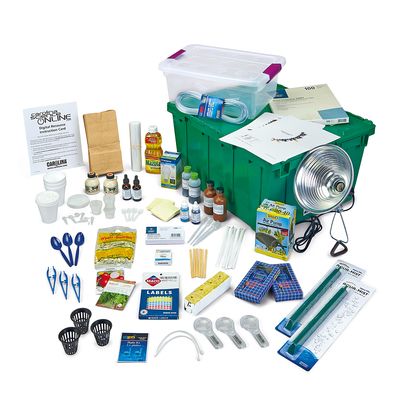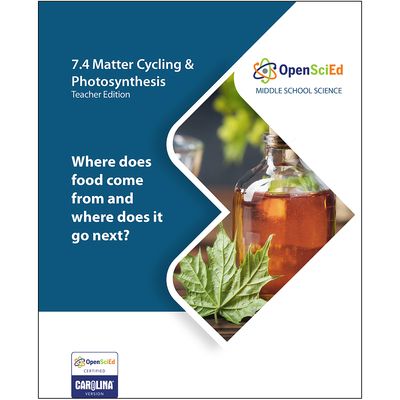Description
For additional program information and pricing, complete this form or contact your sales representative.
Grades 6–8. In Unit 7.4 Matter Cycling and Photosynthesis, Carolina Certified Version*, students work to answer the Unit Driving Question: "Where does food come from, and where does it go next?"
This unit on matter cycling and photosynthesis begins with students reflecting on what they ate for breakfast. Questions about where their food comes from lead them to consider which breakfast items might be from plants. Then students explore (and taste) a common breakfast food, maple syrup. They see that according to the label it is 100% from a tree. Students then see how some trees are tapped in the spring for their sap, and how water is boiled off, to leave only syrup. Students taste maple sap from the trunks of trees and compare it to the maple syrup they tasted earlier.
Students argue (based on what they may have learned in OpenSciEd: Unit 7.3 Metabolic Reactions, items #523801 and #523801U5) that they know what happens to sugar in syrup or other foods when they consume it—it is absorbed into the circulatory system and transported to all cells of their body to be used for growth or fuel. Students explore what else is in food and discover that foods from plants they ate, such as bananas, peanut butter, beans, avocado, and almonds, not only have sugars but also proteins and fats. This leads them to wonder about these molecules in plants: How are plants getting these food molecules? Why does a plant need food in the first place? Where does its food come from?
To figure out how plants could make these food molecules and where plants get the matter and energy to do that, students conduct a series of investigations. Through these investigations, students:
- Develop a model to track the inputs and outputs of plants.
- Carry out experiments to figure out how leaves and seeds interact with the gases in the air around them in the light and the dark.
- Develop and evaluate arguments from their evidence to figure out where plants are getting the energy and matter they need to live.
- Construct an explanation for the central role of photosynthesis in all food production, including synthetic foods.
- Obtain and communicate information to explain how matter gets from living things that have died back into the system through processes done by decomposers.
- Develop and use a model to explain that the major atoms that make up food (carbon, hydrogen, and oxygen) are continually recycled between living and nonliving parts of a system.
This 5-Class Unit Kit includes basic teacher access to instructional materials on CarolinaScienceOnline.com, plus the materials needed to teach 5 classes of 32 students per day (160 students).
Building Toward NGSS Performance Expectations
- MS-PS1-3: Gather and make sense of information to describe that synthetic materials come from natural resources and impact society.
- MS-LS1-2: Develop and use a model to describe the function of a cell as a whole and ways parts of cells contribute to the function.
- MS-LS1-6: Construct a scientific explanation based on evidence for the role of photosynthesis in the cycling of matter and flow of energy into and out of organisms.
- MS-LS2-3: Develop a model to describe the cycling of matter and flow of energy among living and nonliving parts of an ecosystem.
Focal Science and Engineering Practices
- Developing and Using Models
- Engaging in Argumentation from Evidence
- Obtaining, Evaluating and Communicating Information
The following practices are also key to the sensemaking in the unit:
- Asking Questions and Defining Problems
- Planning and Carrying Out Investigations
- Constructing Explanations and Designing Solutions
Focal Disciplinary Core Ideas
- LS1.A.
- LS1.C.
- LS2.B.
- PS1.A.
- PS1.B.
- PS3.D.
Focal Crosscutting Concepts:
- Systems and System Models
- Energy and Matter
The following crosscutting concepts are also key to the sensemaking in the unit:
- Patterns
*All enhancements to materials and instruction for this Carolina Certified Version of the unit are approved by OpenSciEd to preserve the integrity of the storyline and the instructional model.
Specifications
- Shipping Information or Purchase Restrictions
-
- Limited Qty: Corrosive - This product is/contains a limited quantity of a DOT regulated hazardous material. This item will not incur a hazmat fee when shipped by ground. Orders shipping to HI and AK are subject to review and may incur additional shipping charges.
- What’s Included:
-
- Unit Technology Pack (basic digital access to teacher's guide and all instructional resources for the teacher)
- Air Line Tubing, with Markings, 25 ft
- Card Sets, Food Molecules
- Clamp Lamp, with Reflector (without bulb)
- Container, Hydroponics, 3 gal, with Lid
- Forceps, Plastic
- Lenses, Dual Hand
- Net Cups
- Spoons, Plastic, Heavy-Duty
- T Connectors
- Timers, Student
- Top-Loading Sheet Protectors
- Whisper® 40 UL® Aquarium Air Pump
- Air Stones
- Aqua Vega Solution A, 100 mL
- Aqua Vega Solution B, 100 mL
- Bags, Paper, Brown
- Bags, Plastic, Self-Locking, 4 x 6"
- Bags, Resealable, Plastic, 8 x 10"
- Benedict's Solution, 30 mL
- Biuret Solution, 30 mL
- Bromthymol Blue Solution, 100 mL
- Cards, Index, Ruled, 3 x 5"
- Corn Oil, Pint
- Craft Sticks, Wood
- Cup Lids, for Styrofoam® 8-oz Cups
- Cups, Plastic, 1 oz
- Cups, Styrofoam®, 8 oz
- Drinking Straws, Plastic
- Iodine Solution, 1 oz
- Labels, Assorted, 1/4"
- Light Bulb, LED, 15.5 W
- Maple Syrup
- Note Pads, Self-Adhesive, Medium
- pH Paper Dispenser (pH 1.0 to 14.0)
- Pipets, Plastic
- Rockwool Squares
- Seeds, Lima, Bush Bean
- Seeds, Radish, variety 'Scarlet Globe'
- Seeds, Spinach
- Spoons, Taster
- Tubes, Microcentrifuge
expand to see full list - Needed But Not Included:
- Return Policy:
-
If for any reason you are not satisfied with this item, it is eligible for a return, exchange, refund, or credit up to 180 days from date of purchase. Restrictions may apply. Returns & Exchanges Policy.

